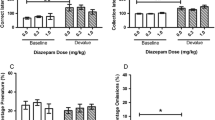Abstract
A procedure was developed with pigeons to extend the experimental analysis of punished behavior and the effects of anxiolytic drugs. Under this procedure the completion of a fixed-ratio requirement on a changeover key switched between two variable-interval schedules of reinforcement that were programmed on a second response key. Under one schedule, correlated with a green keylight, key pecks produced only food; under the second schedule, correlated with a red keylight, key pecks produced both food and electric shock. Pigeons were switched into the component with shock if they did not enter that component within 5 min. Parameter values of the variable-interval schedules were manipulated systematically and the effects of two clinically active anxiolytic drugs, buspirone and chlordiazepoxide, were examined. Responding was suppressed during the component with shock (punishment) and, under non-drug conditions, pigeons infrequently switched into the punishment component; changeover responses occurred rapidly when switched into the punishment component. Both buspirone (0.1–3.0 mg/kg) and chlordiazepoxide (3.0–30 mg/kg) increased punished responding at doses that had little effect on unpunished responding;d-amphetamine (0.3–5.6 mg/kg), which was studied only under one parameter of the variable-interval schedule, produced greater decreases in rates of punished responding than in unpunished responding. Changeover responses were increased only moderately by the anxiolytic drugs when the punishment schedule was added to a 3-min variable-interval schedule and the alternate schedule was a 1-min variable-interval schedule without punishment; the amount of time spent in the punishment component, however, increased two-fold at the higher doses of chlordiazepoxide. When these conditions were reversed and punishment was added to the variable-interval 1-min schedule, time spent in the punishment component increased and changeover responses out of the punishment component decreased, particularly following chlordiazepoxide. Anxiolytic drugs appear to attenuate the aversiveness of stimuli correlated with punishment, but the degree of attenuation is controlled by other conditions prevailing in the presence of those stimuli.
Similar content being viewed by others
References
Barrett JE (1992) Studies on the effects of 5-HT1A drugs in the pigeon. Drug Dev Res 26:299–317
Barrett JE, Gleeson S (1991) Anxiolytic effects of 5-HT1A agonists, 5-HT3 antagonists and benzodiazepines: conflict and drug discrimination studies. In: Rodgers RJ, Cooper SJ (eds) 5-HT1A agonists, 5-HT3 antagonists and benzodiazepines (their comparative behavioural pharmacology). John Wiley, Chichester, England, pp 59–105
Barrett JE, Witkin JM (1991) Buspirone in animals models of anxiety. In: Tunnicliff G, Eison A, Taylor D (eds) Buspirone: mechanisms and clinical aspects. Academic Press, Orlando, pp 37–79
Barrett JE, Witkin JM, Mansbach RS, Skolnick P, Weissman BA (1986) Behavioral studies with anxiolytic drugs. III. Antipunishment actions of buspirone in the pigeon do not involve benzodiazepine receptor mechanisms J Pharmacol Exp Ther 238:1009–1013
Brocco MJ, Koek W, Degryse AD, Colpaert FC, (1990) Comparative studies on the anti-punishment effects of chlordiazepoxide, buspirone and ritanserin in the pigeon, Geller-Seifter and Vogel conflict procedures. Behav Pharmacol 1:403–418
Geller I (1964) Relative potencies of benzodiazepines as measured by their effects on conflict behavior. Arch Int Pharmacodyn 149:243–247
Geller I, Seifter J (1960) The effects of meprobamate, barbiturates,d-amphetamine and promazine on experimentally induced conflict in the rat. Psychopharmacologia 1:482–492
Gleeson S, Ahlers ST, Mansbach RS, Foust JM, Barrett JE, (1989) Behavioral studies with anxiolytic drugs. VI Effects on punished responding of drugs interacting with serotonin receptor subtypes. J Pharmacol Exp Ther 250:809–817
Goldberg HL, Finnerty RJ (1979) The comparative efficacy of buspirone and diazepam in the treatment of anxiety. Am J Psychiatry 136:1184–1187
Goldberg HL, Finnerty RJ (1982) Comparison of buspirone in two separate studies. J Clin Psychiatry 43:87–91
Mansbach RS, Harrod C, Hoffman SM, Nader M, Lei Z, Witkin JM, Barrett JE (1988) Behavioral studies with anxiolytics drugs. V. Behavior and in vivo neurochemical analyses in pigeons of drugs that increase punished responding. J Pharmacol Exp Ther 246:114–120
Nanry KP, Howard JL, Pollard GT (1991) Effects of buspirone and other anxiolytics on punished key-pecking in the pigeon. Drug Dev Res 24:269–276
Rickels K, Weissman K, Norstad N, Singer M, Stoltz D, Brown A, Danton J (1982) Buspirone and diazepam in anxiety: a controlled study. J Clin Psychiatry 43:81–86
Sepinwall J, Grodsky FS, Cook L, (1978) Conflict behavior in the squirrel monkey: effects of chlordiazepoxide, diazepam, and n-desmethyldiazepam. J Pharmacol Exp Ther 204:88–102
Thomas DA, Weiss SJ, Schindler CW (1990) Effects of chlordiazepoxide and flumazenil on preference for punished and unpunished response alternatives in rats. Psychopharmacology 102:333–338
Witkin JM, Mansbach RS, Barrett JE, Bolger GT, Skolnick P, Weissman B (1987) Behavioral studies with anxiolytic drugs. IV. Serotonergic involvement in the effects of buspirone on punished behavior of pigeons. J Pharmacol Exp Ther 243:970–977
Witkin JM, Barrett JE (1986) Interaction of buspirone and dopaminergic agents on punished behavior of pigeons. Pharmacol Biochem Behav 24:751–756
Author information
Authors and Affiliations
Rights and permissions
About this article
Cite this article
Wojnicki, F.H.E., Barrett, J.E. Anticonflict effects of buspirone and chlordiazepoxide in pigeons under a concurrent schedule with punishment and a changeover response. Psychopharmacology 112, 26–33 (1993). https://doi.org/10.1007/BF02247360
Received:
Revised:
Issue Date:
DOI: https://doi.org/10.1007/BF02247360




